InnovationAus.com foreshadowed two candidates for the Communications portfolio; and one of them was successful.
Senator Fifield comes with the background of having been the Communications Portfolio representative in the Senate. He will have read many of the “question time briefs” (the name varies depending on Ministers and portfolios) and certainly has sat through every Senate Estimates.
He knows the lie of the land and is a nice safe pair of hands.

Senator Fifield has also picked up the title of “Minister Assisting the Prime Minister for Digital Government” located within the Prime Minister’s portfolio. Just as adding Innovation to the Industry portfolio, this is a blowback to the second Gillard ministry.
After the 2010 election Senator Conroy was also named “Minister Assisting the Prime Minister on Digital Productivity.” That appointment reflected the need for the Minister to have an “all of Government” responsibility to prosecute the development of initiatives to flesh out the National Digital Economy Strategy.
A consequence of that move was the inclusion of additional initiatives when the update to the strategy, Advancing Australia as a Digital Economy, was released.
The publication of the Administrative Arrangements Order on Monday makes more of the detail clearer.
Responsibility for “government service delivery” has been transferred from the Communications Portfolio to the Prime Minister’s Portfolio. However as the DTO was a standalone agency and Senator Fifield is also Minister responsible, it only relates to which portfolio will make the budget available and hence which Senate Estimates committee will question progress and expenditure.
The Coalition’s 2013 Policy for e-Government and the Digital Economy promised an update to the NDES in the first term of Government. The Administrative Arrangements Order adds to the Industry Innovation and Science Portfolio “National policy issues relating to the digital economy.” That confirms the information provided to my colleague James Riley that the responsibility for that update will be part of the innovation rather than communications brief.
A malicious person would think the Digital Economy issues have been moved to hide the lack of progress on them after two years under Mr Turnbull.
The question really is what is left for the innovation department to do. As Communications Minister Malcolm Turnbull was very clear in January after the Digital transformation Office was announced.
He started the blog post saying:
I am often asked, ‘what is the government doing to drive innovation across the economy’? This sounds like a contradiction – an oxymoron – because governments, despite their best intentions, are rarely hotbeds of innovation.
Nothing drives performance quite like the bottom line, so for business there is an incentive to continually innovate – to incrementally improve performance to maximise returns. The incentives are not as clear cut for governments. But nonetheless government has an important role to play in supporting innovation.
He identified a number of areas for action:
- Investing in the enablers of productivity and innovation like science, research, education and infrastructure;
- Changes to employee share schemes and crowd sourced funding;
- Government innovating its own operations and leading by example.
That seems to be the entire scope of the Prime Minister’s ambitions; and they are all already in train.
As detailed previously at InnovationAus.com the previous Government had identified seven enablers and initiatives against eight target areas. These included all the items on Mr Turnbull’s list – and many more besides.
Between the previous Minister for Industry’s own Innovation and Competitiveness Agenda, the review already commissioned by Pyne as Education Minister that includes reviewing “incentives to universities to increase and improve engagement and collaboration with industry” and the stalled STEM strategy it looks like everything that Mr Turnbull thinks can be done to support innovation is being done.
Bill Shorten tried last week to make the issue about whether the change of Prime Minister is really about a change of policy or just a change of spokesman. If he had better staff he would have been able to make the case that the new PM is talking up innovation but his own previous statements reveal it is nothing but spin.
Mitch Fifield will be a safe pair of hands in Communications, and one of the options for machinery of Government changes we suggested will occur.
The Administrative Arrangements Order reveals that copyright and classification will join the Arts in being moved from the Attorney-General to the Communications portfolio.
Feel sorry for the staff in Arts – they have been MoG’d (as it is known) quite a lot over recent years.
With the first Rudd Government they were moved to Environment and Heritage under Peter Garrett. They were then moved to the Simon Crean’s Regional Development portfolio in the Gillard Government until his implosion in March 2013. They then returned to Environment under Tony Burke. With the advent of the Abbott Government they moved to Attorney-General’s.
Hopefully the opportunity will be used to embrace the ALRC recommendation for a single nationally legislated scheme.
Copyright also is an economic not a legal issue. The question is what rights and protections do the creators of content deserve. Hopefully Communications will take a more enlightened approach to the question of Fair Use policy.
Copyright and classification are intricately related to the changes in content delivery platforms occurring through digital disruption. But to move these into the Department responsible for the National Broadband Network while moving responsibility for the Digital Economy out is akin to thinking the NBN is just a giant video entertainment system.
And that, as we know, was the previous PM’s depth of understanding of the economic implications of broadband.
This is the second in a two part series examining Turnbull’s new cabinet. The first part in the series looks at the science and innovation and you can read it here.
Do you know more? Contact James Riley via Email.

